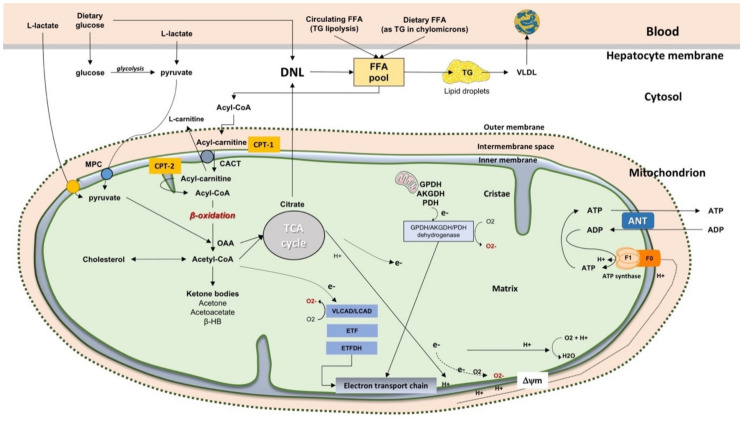Figure 1.
Mitochondrial function in the liver. Oxidative metabolism and hepatocyte energy homeostasis depend on FFA β-oxidation, the tricarboxylic acid cycle (TCA), electron flow along the electron transport chain, electrochemical proton gradient generation, and ATP synthesis. Ketone bodies are produced due to an absence of oxaloacetate used in gluconeogenesis (e.g., starvation and diabetes). Starting from blood, dietary glucose, dietary FFA (as TG within chylomicrons) and FFA circulating after TG lipolysis, enrich the FFA pool in the hepatocyte. During fatty acid synthesis, glucose from dietary sources during glycolysis is converted to pyruvate which can enter the mitochondrion via the mitochondrial pyruvate carrier (MPC). Pyruvate also can be synthesised from L-lactate after transport of L-lactate in the matrix, via its own carrier, and oxidation via the mitochondrial L-lactate dehydrogenase [19,20]. In the mitochondrial matrix, pyruvate provides acetyl-CoA via the pyruvate dehydrogenase complex and oxaloacetate (OAA) involving the pyruvate carboxylase. Due to citrate synthase, pyruvate and oxaloacetate give citrate which can be exported to allow for FFA synthesis is the cytoplasm in the de novo lipogenesis (DNL). Abbreviations: ACC, acetyl-CoA carboxylase (ACC); ANT, adenine nucleotide translocator; CACT, carnitine-Acylcarnitine Transferase; CPT-1, carnitine palmitoyltransferase-1; CPT-2, carnitine palmitoyltransferase-2; DNL, de novo lipogenesis; electron transfer flavoprotein (ETF); ETFDH, ETF dehydrogenase; FFA, free fatty acids; β-HB, β-hydroxybutyrate; MPC, mitochondrial pyruvate carrier; OAA, oxaloacetate; PEP, phosphoenolpyruvate; TG, triglycerides; VLDL, very low-density lipoprotein [16,21].

